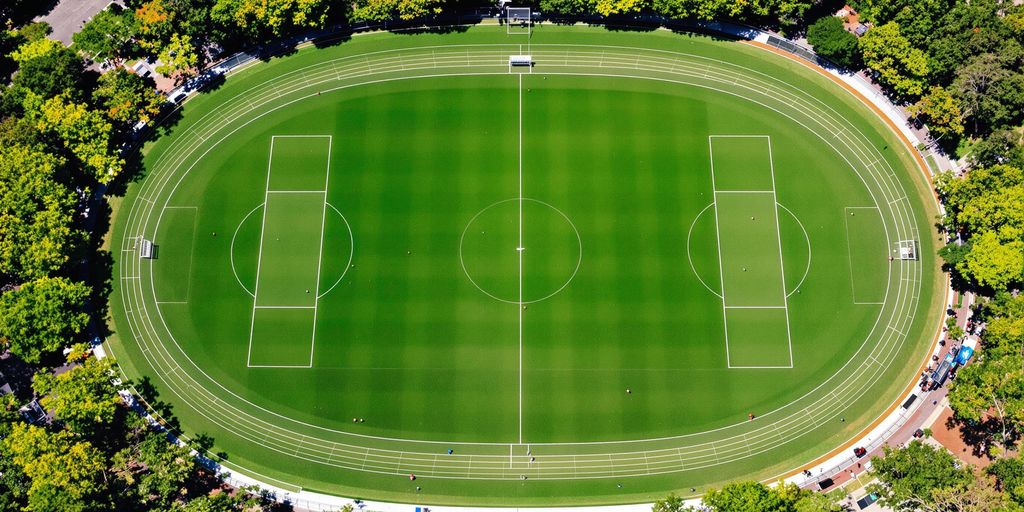Understanding AFL Oval Dimensions
Standard Length and Width
Okay, so when we talk about AFL ovals, the first thing to get your head around is that they’re not all exactly the same size. The ideal dimensions are between 135-185 metres long and 110-155 metres wide. It’s a bit like saying a car is ‘medium-sized’ – there’s a fair bit of wiggle room. This range allows for different grounds to accommodate both AFL and cricket, which is pretty common.
Variations in Oval Sizes
Now, why the variation? Well, a few things come into play. Older grounds, especially those in inner-city areas, might be a bit smaller because, well, they were built a while ago when land wasn’t as available. Newer grounds out in the suburbs tend to be closer to those maximum dimensions. Also, some ovals are specifically designed to fit a cricket pitch in the middle, which can affect the overall shape and size. It’s not a perfect science, and you’ll find that each oval has its own quirks.
Importance of Field Dimensions
Why does the size of the oval even matter? It actually has a big impact on the game. A bigger ground means more running, more space to move the ball, and potentially more long kicks. Smaller grounds can lead to more contested footy, tighter packs, and a faster, more physical game. The dimensions influence strategy, player fitness, and even the type of players a team might recruit.
Think of it this way: a team that’s good at long, sweeping plays might prefer a bigger ground, while a team that thrives on contested possessions might do better on a smaller one. It’s all part of the tactical game within the game.
Calculating the Perimeter of an AFL Oval
Formula for Perimeter Calculation
Okay, so working out the distance around an AFL oval isn’t as straightforward as measuring a square footy field. Because ovals are, well, oval, there’s no simple length times width calculation. The shape is more like an ellipse, or two semi-circles joined by straight lines. The formula to get a pretty good estimate involves a bit of maths, but don’t stress, it’s manageable. You’ll need the length and width of the oval. A common formula used is an approximation based on the ellipse perimeter formula, which can look something like this:
Perimeter ≈ π * [3(a + b) – √((3a + b)(a + 3b))]
Where:
- a = half of the major axis (half the length)
- b = half of the minor axis (half the width)
Keep in mind this gives an approximate perimeter. For super accurate measurements, you’d need surveying equipment.
Factors Affecting Perimeter
Right, so you’ve got your formula, but a few things can throw off your calculation. First off, AFL ovals aren’t all the same size. There’s a range of acceptable lengths and widths, so the perimeter changes depending on the specific ground. Also, the shape isn’t a perfect ellipse. Some ovals are a bit more squashed or stretched than others, which affects the curve and, therefore, the perimeter. Run-off areas also need to be considered; these are extra spaces around the actual playing surface, and while not part of the official perimeter, they impact player movement and field size perception.
Comparison with Other Sports Fields
An AFL oval is significantly larger than most other sports fields. Think about it: a soccer pitch or a rugby field is rectangular, making their perimeters easier to calculate and generally smaller. A cricket ground, which is often inside an AFL oval, has a very different shape and size again. This larger size means AFL players cover much more ground during a game compared to sports played on smaller fields. Here’s a quick comparison:
| Sport | Typical Perimeter (Approx.) |
|---|---|
| AFL Oval | 450 – 550 metres |
| Soccer Field | 380 – 420 metres |
| Rugby Field | 340 – 380 metres |
| Cricket Ground | Varies Greatly |
The sheer size of an AFL oval contributes to the unique demands placed on players. The running distances, the open space for marking contests, and the strategic importance of field positioning are all directly influenced by the oval’s dimensions and perimeter.
Significance of Oval Shape in AFL

The oval shape isn’t just some random design choice; it’s baked right into the heart of Aussie Rules. It affects everything from how the game is played to the strategies teams employ. It’s a pretty big deal, actually.
Impact on Gameplay
The oval shape creates a unique playing environment. Unlike a rectangular field, there are no corners. This means players need to be adaptable and aware of angles at all times. The constant movement and open space encourage a free-flowing style of play, which is what makes AFL so exciting to watch. The shape also influences kicking strategies, as players need to account for the curvature when aiming for targets downfield. It’s not as simple as kicking straight; you’ve gotta think about the angles.
Strategic Advantages
The oval’s shape offers strategic depth. Teams can use the wings of the oval to spread play and create scoring opportunities. The lack of defined corners means players need to be versatile and able to play multiple positions. Coaches often use the oval’s shape to their advantage, setting up plays that exploit the open spaces and force opponents into difficult positions. It’s like a giant chess board, but with more running and less sitting.
Historical Context
The oval shape has been a part of AFL since its early days. It was originally designed to accommodate cricket during the summer months, which is why many AFL grounds still have cricket pitches in the centre. This dual-purpose design has shaped the game’s evolution, influencing the way it’s played and the types of skills that are valued. It’s a bit of a quirky origin story, but it’s part of what makes AFL unique.
Here’s a quick look at how oval usage has evolved:
- Early Days: Primarily for cricket and Aussie Rules.
- Mid-20th Century: Increased focus on football, but cricket still important.
- Modern Era: Dedicated AFL grounds emerge, but shared venues remain common.
AFL Oval Design Considerations
Designing an AFL oval is more than just drawing an oval shape on a field. It’s a complex process that considers player safety, gameplay, and even the possibility of sharing the space with other sports, like cricket. Let’s have a look at some of the key things that need to be thought about.
Field Surface Requirements
The surface of an AFL oval needs to be top-notch. It needs to be able to handle the wear and tear of a full AFL season, which means choosing the right type of grass and making sure the drainage is spot on. You don’t want players slipping and sliding all over the place after a bit of rain. The profile of the playing surface needs to meet the needs of the users, so that the performance of the profile can cater for the proposed weekly hours of use.
- The grass needs to be hard-wearing.
- Drainage is critical to avoid waterlogging.
- The surface needs to be even and free of hazards.
Run-off Areas
Run-off areas are the spaces around the edge of the playing field. They’re there to give players a bit of extra room to slow down or stop if they’re running at full speed. Getting the geometry right is more than just the length and width. Run-offs need to be meet, which means that all perimeter infrastructures need to be outside the run-off offset.
- They need to be wide enough to be effective.
- The surface should be similar to the playing field.
- They need to be free of obstructions.
Incorporation of Cricket Wickets
Many AFL ovals also double as cricket grounds, so the design needs to take this into account. This usually means having a cricket wicket in the centre of the oval, which can affect the way the ground is used for AFL. The inclusion of a cricket wicket within an oval is a common consideration.
- The wicket needs to be properly prepared and maintained.
- It shouldn’t interfere with AFL gameplay.
- The changeover between sports needs to be smooth.
Designing an AFL oval is a balancing act. You’ve got to think about the needs of the players, the fans, and any other sports that might be using the ground. It’s not just about kicking a footy; it’s about creating a space that’s safe, functional, and enjoyable for everyone.
Distance Covered by Players During Matches
Average Distance Run
AFL players are seriously fit, and it shows in the distances they cover during a match. On average, an AFL player will run between 12 to 14 kilometres in a single game. That’s a fair hike when you consider the constant sprinting, tackling, and marking involved. Some midfielders and outside runners can even clock up over 16 kilometres. It’s wild, really.
Factors Influencing Distance
Several things affect how far a player runs during a game. These include:
- Position: Midfielders typically run the most, followed by wingmen and half-backs.
- Game Style: A fast, open game will generally mean more running than a contested, stoppage-heavy match.
- Player Fitness: A player’s individual fitness level obviously plays a big part.
- Tactical Role: Some players might be assigned specific running roles, like tagging an opponent.
It’s not just about the total distance, though. The intensity of the running matters too. AFL players do a lot of high-intensity sprints, which are way more taxing than jogging around the park.
Comparison with Other Sports
Compared to other sports, the distance covered in AFL is pretty impressive. Here’s a quick comparison:
| Sport | Average Distance Covered | Notes |
|---|---|---|
| AFL | 12-14 km | High intensity, frequent sprints |
| Soccer | 9-12 km | More continuous running |
| Basketball | 4-5 km | Short bursts, lots of changes in direction |
| American Football | 1-2 km | Stop-start, less overall running |
So, yeah, AFL players definitely earn their keep with the amount of ground they cover.
AFL Oval Maintenance Practises
Importance of Regular Maintenance
Keeping an AFL oval in top nick isn’t just about aesthetics; it’s essential for player safety and the quality of the game. A well-maintained surface reduces the risk of injuries and ensures consistent ball bounce and roll. Think of it like this: you wouldn’t drive a car without regular servicing, would you? Same goes for an AFL oval. Regular maintenance also extends the lifespan of the turf, saving money in the long run.
Techniques for Maintaining Turf
Maintaining an AFL oval is a year-round job. Here’s a few things that need to be done:
- Mowing: Regular mowing keeps the grass at the right height, promoting healthy growth and a consistent surface.
- Irrigation: Proper watering is crucial, especially during dry periods. Overwatering can lead to fungal diseases, while underwatering can cause the turf to dry out and become brittle.
- Fertilising: Applying the right fertiliser provides the nutrients the grass needs to thrive. Soil testing helps determine the specific nutrient requirements.
- Aeration: Aerating the soil improves drainage and allows air and nutrients to reach the roots. This is often done using a machine that punches small holes in the turf.
- Weed and Pest Control: Regular monitoring and treatment are necessary to prevent weeds and pests from damaging the turf.
Good drainage is also super important. Nobody wants to play on a waterlogged oval. Installing and maintaining effective drainage systems is key to preventing water from pooling on the surface.
Seasonal Considerations
The maintenance regime for an AFL oval needs to adapt to the changing seasons.
- Summer: Increased irrigation is usually required to combat the heat. Mowing may need to be more frequent to manage growth.
- Autumn: This is a good time for aeration and fertilising to prepare the turf for the cooler months.
- Winter: Growth slows down, so mowing frequency can be reduced. Focus shifts to protecting the turf from frost and disease.
- Spring: As the weather warms up, growth accelerates. Increased mowing and fertilising are needed to promote healthy growth and repair any damage from the winter months. Overseeding might be required to fill in bare patches.
Historical Evolution of AFL Ovals
Early Designs and Changes
Okay, so picture this: footy’s early days. The grounds? Not exactly the pristine ovals we see today. They were rough, often shared with other sports, and the dimensions? Well, let’s just say standardisation wasn’t really a thing. Early grounds varied wildly in size and shape, which definitely impacted how the game was played. Think about it – a smaller ground meant more congestion, a bigger one favoured long kicking. It was a bit of a free-for-all, really.
Influence of Technology
As time went on, things started to change, and technology played a big part. Better surveying equipment meant more accurate measurements, and improved construction techniques allowed for better drainage and surface quality. Suddenly, grounds could be more consistent and reliable. The introduction of synthetic grass also changed the game, offering a durable alternative to natural turf, especially in areas with harsh climates or heavy usage. It wasn’t just about the size anymore; it was about the quality of the playing surface.
Modern Standards
These days, AFL ovals are a far cry from those early paddocks. There are strict guidelines about dimensions, surface materials, and safety features. The AFL has specific requirements to ensure fair play and player safety. Here’s a quick rundown:
- Length: Typically between 135m and 185m
- Width: Usually between 110m and 155m
- Surface: High-quality turf or approved synthetic alternatives
Modern AFL ovals are designed with both the players and the fans in mind. Run-off areas are carefully planned to minimise injuries, and sightlines are optimised to provide the best possible viewing experience. It’s all about creating a world-class sporting venue.
And it’s not just about the game itself. Many ovals now incorporate facilities for other sports, like cricket, making them multi-purpose venues for the whole community. It’s a long way from those early, rough-and-ready grounds, that’s for sure!
AFL Oval Usage Beyond Football
AFL ovals aren’t just for footy, mate. They’re versatile spaces that get used for all sorts of things. It’s pretty common to see them hosting other sports, community events, and even cultural festivals. This multi-purpose nature makes them important hubs in many towns and cities.
Multi-sport Facilities
Loads of AFL ovals double as cricket grounds, especially during the summer months. You’ll often see a cricket wicket smack-bang in the middle of the oval. Some ovals also host soccer or rugby matches, although the oval shape isn’t always ideal for those sports. The key is adaptability, and many councils work hard to ensure the grounds can cater to different sporting codes.
Community Events
Ovals are great for community events. Think local markets, fairs, and even outdoor movie nights. They provide a big, open space that’s perfect for bringing people together. Plus, they often have existing facilities like toilets and parking, which makes event planning a whole lot easier. Councils often use them for things like Australia Day celebrations or Christmas carols.
Cultural Significance
Beyond sports and events, AFL ovals can hold cultural significance for local communities. They might be the site of important historical events or serve as a gathering place for Indigenous Australians. The ovals become a focal point for community identity and social interaction. They’re more than just a patch of grass; they’re part of the town’s story.
Ovals are often at the heart of a town. They’re where people come together to celebrate, compete, and connect. Their importance extends far beyond just being a sports ground; they’re a vital part of the community’s social fabric.
Regulations Governing AFL Ovals
AFL Guidelines for Field Dimensions
When it comes to AFL ovals, there are specific guidelines that the AFL puts in place to ensure fair play and consistency across all venues. These guidelines cover everything from the length and width of the oval to the placement of goalposts and boundary lines. These dimensions are crucial for maintaining the integrity of the game. It’s not just about having a big, grassy area; it’s about having a precisely measured and marked field. The Country Football Programme also has guidelines for field dimensions.
Safety Standards
Safety is a big deal in AFL, and the regulations for ovals reflect that. This includes things like adequate run-off areas to prevent players from crashing into fences or other obstacles. The surface of the oval also needs to meet certain standards to minimise the risk of injuries, like ancle sprains or worse. Think about it – a poorly maintained oval can be a hazard. It’s all about making sure the players are as safe as possible while they’re out there giving it their all. The run-offs are important for player safety.
Compliance and Inspections
To make sure that all AFL ovals meet the required standards, there are regular compliance checks and inspections. These inspections look at everything from the dimensions of the field to the quality of the turf and the adequacy of safety measures. If an oval doesn’t meet the standards, it might not be allowed to host AFL games until the issues are fixed. It’s a bit like getting a roadworthy certificate for your car – you need to pass the test to be allowed on the road, or in this case, the field.
Ensuring compliance isn’t just about ticking boxes; it’s about maintaining a level playing field (literally!) and protecting the players. Regular inspections help identify potential problems before they lead to injuries or unfair advantages.
Impact of Weather on AFL Ovals
Weather plays a massive role in Aussie Rules, impacting everything from player performance to the condition of the oval itself. You wouldn’t think about it much, but the weather can really change the game.
Effects of Rain and Wind
Rain can turn an AFL oval into a slippery mud bath, affecting ball handling and player movement. The ball becomes heavier and harder to grip, leading to more dropped marks and scrappy play. Wind, especially a strong breeze, can significantly influence kicking accuracy and the flight of the ball. A well-placed kick with the wind can travel much further, while kicking against it becomes a real struggle. It’s not just the players who have to adapt; umpires need to adjust their positioning and decision-making too.
Seasonal Variations
AFL season runs through the Aussie winter and early spring, meaning games are often played in cold and wet conditions, particularly in southern states. Groundskeepers have to work hard to maintain the turf during these months, battling waterlogging and slow grass growth. Summer games, while less common, can bring extreme heat, which can lead to player fatigue and dehydration. The AFL has heat policies in place to protect players during these conditions, including extra breaks and increased hydration opportunities.
Adaptations by Players
Players and coaches need to adapt their strategies based on the weather conditions. In wet weather, teams might focus on contested possessions and ground balls, rather than high-flying marks. Kicking long down the line becomes more effective, and the importance of strong tackling increases. In windy conditions, teams might prefer to kick with the wind whenever possible, or use shorter, more accurate passes. Players also adjust their footwear, opting for boots with longer studs for better grip in muddy conditions. It’s all about being adaptable and making the most of AFL guidelines for field dimensions, no matter what the weather throws at you.
I remember one game last year where it was pouring rain. You could barely see the other end of the ground. The players were covered in mud from head to toe, and the ball looked like a bar of soap. It was a real slog, but it made for some exciting footy. The team that adapted best to the conditions ended up winning, proving that mental toughness is just as important as physical skill in those situations.
Future Trends in AFL Oval Design
Innovations in Field Technology
Okay, so what’s next for the humble footy oval? Well, heaps, actually. We’re talking about some pretty cool tech advancements that could change the game, literally. Think about it: embedded sensors in the turf to monitor player impact and field conditions in real-time. This data could then be used to improve player safety and optimise training regimes. There’s also the potential for smart turf that can adjust its properties based on weather conditions, providing consistent playing surfaces no matter what Mother Nature throws our way.
Sustainability Practises
Sustainability is a big one, and it’s only going to get bigger. Ovals use a lot of water and resources, so finding ways to reduce that impact is crucial. Here are a few things we might see more of:
- Water recycling systems to capture and reuse rainwater.
- Drought-resistant turf varieties that require less irrigation.
- Solar panels integrated into stadium infrastructure to power lighting and other systems.
- Use of recycled materials in construction and maintenance.
It’s not just about being green; it’s about making sure these ovals can keep going for generations to come. We need to think long-term and invest in solutions that are both environmentally and economically sound.
Designing for Fan Experience
Let’s not forget the fans! The game is nothing without them, so making the oval a better place to watch footy is key. This means more than just comfy seats and better food. We’re talking about things like:
- Improved sightlines from all areas of the ground.
- Interactive displays and augmented reality experiences to enhance the game-day atmosphere.
- Better accessibility for people with disabilities.
- More diverse food and beverage options to cater to different tastes.
And maybe, just maybe, heated seats for those freezing winter games!
Understanding the Role of Umpires on the Oval

Umpire Positioning
Umpire positioning during an AFL match is absolutely critical. They need to be everywhere at once, or at least, that’s how it seems! Umpires are trained to position themselves to have the best possible view of play, which often means running constantly to keep up with the ball movement. It’s not just about being close to the action; it’s about being in the right spot to see potential infringements, like holding the ball or a free kick. They work as a team, with field, boundary, and goal umpires all having specific zones of responsibility to ensure comprehensive coverage of the oval.
Decision Making on the Field
Umpires have to make split-second decisions that can significantly impact the game’s outcome. These decisions range from awarding free kicks to calling marks and determining whether a player has disposed of the ball legally. It’s a tough gig, and they’re under constant scrutiny from players, coaches, and fans. The umpires use signals to communicate decisions, and score reviews can be used to challenge incorrect calls.
Impact on Game Flow
The umpires’ decisions directly influence the flow of the game. A quick whistle can stop momentum, while letting play continue can allow for exciting passages of play. It’s a balancing act, and experienced umpires develop a feel for when to intervene and when to let the game run. The holding-the-ball rule, for example, is a frequent source of contention, as umpires must judge whether a player had a reasonable opportunity to dispose of the ball. Here are some factors that influence the game flow:
- Consistency in decision-making
- Clear and concise communication
- Application of advantage rule
Umpires are human, and mistakes happen. The speed and intensity of AFL mean that they can’t possibly see everything. The goal is always to make the best decision possible in the moment, and to maintain the integrity of the game.
Wrapping It Up
So there you have it! The distance around an AFL oval can vary quite a bit, but generally, you’re looking at around 400 to 500 metres. It’s a big space that really adds to the excitement of the game. Whether you’re watching from the stands or playing on the field, knowing the size of the oval can help you appreciate the skill and stamina of the players. Next time you’re at a match, take a moment to soak in the whole scene. It’s not just about the game; it’s about the atmosphere, the crowd, and the thrill of Aussie Rules. Cheers!




